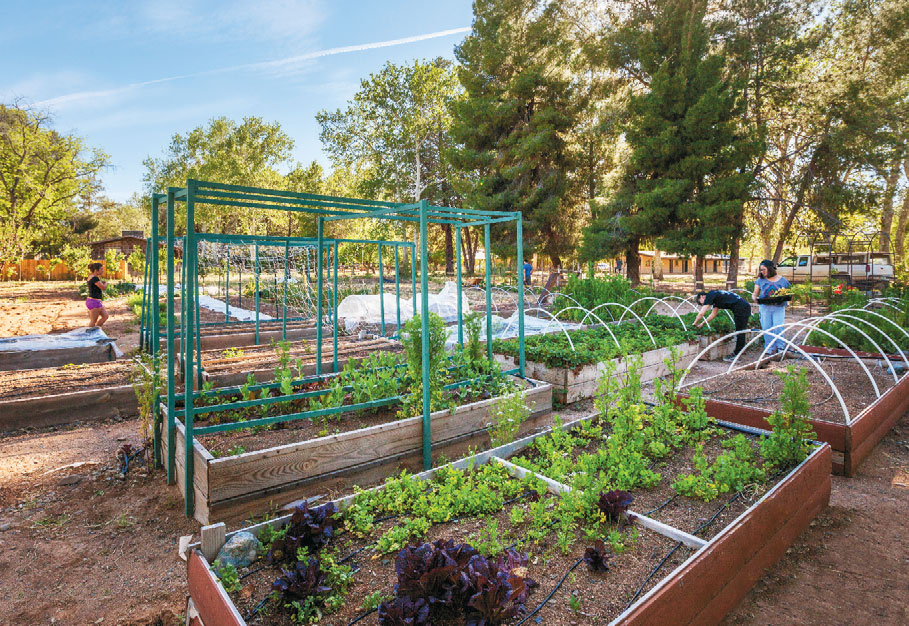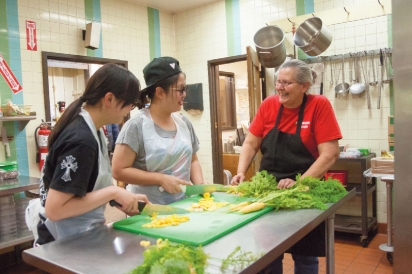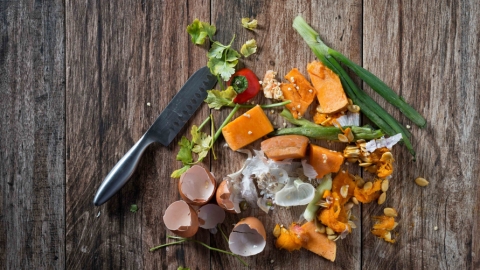Changing the Food Culture at Orme School
CHALLENGES, PERSISTENCE AND PASSION
Patti Marrs had a dilemma. Her kitchen was fully stocked with food she would not use. On her first day at her new job as food service director for The Orme School, a private college preparatory boarding school for boys and girls set in the Arizona high country, she surveyed the kitchen pantry, refrigerator and freezer: powdered pudding mix, canned fruit salad, imitation cheese sauce, pressed processed meats, frozen breaded chicken nuggets, puffy white bread, 50 pounds of trans-fat margarine, free-flowing soda fountains with sugary chocolate milk and blue sport drinks, and a full complement of Styrofoam dinnerware.
This disturbing scene was a picture of typical institutional food service, featuring industrial processed food with a long shelf life. The ingredients were high in refined carbohydrates, sugar, high-fructose corn syrup (HFCS), artificial colors and flavors, saturated and trans fats and genetically modified organisms (GMOs), and low in nutrients like vitamins, minerals, fiber, antioxidants and healthy fats. There were few fresh fruits and vegetables, nothing locally sourced and no whole grains. The staff did not cook. They opened bags, cans and boxes and then heated what was inside.
Fortunately, leadership at The Orme School had recognized that this food was not the best choice for their students and for their commitment to sustainability, health and wellness. Orme wanted something better: a food system that could enhance the students’ knowledge of where their food comes from. They made the decision to transition from the traditional, contracted food service to an independently run kitchen and see what could be done. And so they hired Patti.
First Patti decided the old food must go. She couldn’t, just couldn’t, start her job to feed students all their meals, three times a day, with those ingredients. She decided to donate everything to the food bank. Patti felt a twinge of guilt about that, passing on nutrient-poor, highly processed food that she would rather have sent to the dump.
At this point you’d think Patti was a trained, experienced and dedicated foodie chef, but actually she was just a good everyday home cook. She entered food service via the business office as an accountant at the Verde Valley School (another private boarding school) in Sedona. From her perch in the business office she saw the real costs of corporate food service including the waste, toll on student health, low-paid prep staff and the lack of environmental values and she resolved to make improvements. Changing a food culture is a difficult challenge even for crusading chefs and food service managers but that first year at Verde Valley she saved 33% in food and production costs for the school.
Now she had promised to do the same for The Orme School—to serve fresh, nutritionally superior food, maintain high environmental values and save money. How?
The first challenge was to put the kitchen staff to work. Instead of “heat and eat” they were given the opportunity to utilize their cooking skills, to “clean, cut and cook.” The work became more intense, involved and difficult. There were fewer coffee breaks, less slack time and no waiting around. Kitchen work became a hustle. For balance, Patti won a living wage for her workers because, “well, they need to live.” And the staff started enjoying their work and taking pride in what they were producing.
The next challenge was finding decent ingredients in foodservice sizes. Just where do you find all-natural mayonnaise or ketchup in institutional sizes? The first job was to scan the thousands upon thousands of choices offered by the big food suppliers. Which of these things were natural, chemical free and unprocessed, yet still retained full nutrition and flavor? Patti knuckled down, studied and researched, found new suppliers and encouraged old suppliers to add to their choices, a neverending job that continues to this day.
Patti hunted for local food sources. She had to chase down farmers, ranchers and bakers and persuade them to sell to her in the quantities she needed—cases, not pieces, and delivered, please . . .—but then she usually had to run around to pick them up on her daily commute to the kitchen. But there was another challenge with this: the county health department required that all vegetables, eggs and meat come from an “approved source.” None of these small farms were approved and the health department had no program for certifying them. Standard certification procedures were for the big boys, with big farms. Patti worked with a team of local health department staff and the farmers to suggest a solution, and now these smaller-scale farmers can follow an approval process to legally sell their produce to food service and restaurant kitchens.
Around the same time, The Orme School was developing a plan to further their “Farm to Table” initiative. Why not grow the food right here? The campus is ideally located midway between desert and mountains with Ash Creek running right through it. And The Orme School had a history in agriculture; it survived the 1929 depression by growing and selling carrots. Patti honors this tradition by serving carrots at every meal (see sidebar carrot recipe).
And so, with the lead of science teacher Emerson “Casey” Jones, and with the encouragement of the headmaster and CFO, they restarted the campus garden and planted a fruit and nut orchard with 200 trees. Casey had an extensive background in horticulture, so he involved the students in the garden and blended the garden experience into his science curriculum. Since the planting in spring 2015, students are now able to experience where their food comes from, from soil to seed to harvest to table.
With the newly productive garden, yet another bureaucratic obstacle appeared. Vegetables from the school’s garden could be used in the classroom but were not allowed in the cafeteria. Fortunately, several schools across the state were encountering this barrier at the same time. As a result, the Arizona Department of Health Services (ADHS) launched their School Garden Program and began helping school gardens to become “approved sources.”
Patti enrolled in a mind-boggling two-day class and brought back a three-inch-thick book of commercial regulations for agribiz farms. She asked for help again and walked the property with the state agricultural agents, asking “How am I going to do this?” She worked one-on-one with the Arizona Department of Agriculture and spent three months writing a plan. Her plan was accepted by the agency, and The Orme School’s garden was among the first to be “approved” in Arizona.
After that, Patti’s plan was simplified down to a check list, so now the process is easy for other schools to complete. There are now 22 certified school gardens in Arizona—thanks to Patti’s pioneering work.
It wouldn’t be fair to say that Patti didn’t also face internal challenges. The leadership at The Orme School was supportive but it’s hard to break the junk food habits of a school full of your average teenagers. Even though Patti was providing superior quality, wholesome and nutritious food, the students didn’t know it. To help the students synthesize the changes, The Orme School Sustainability Program put students to work for one class period each day on a rotation from garden to kitchen to dining hall to grounds, using their help wherever they were needed. All students have food handler’s training. They plant, harvest, cook and eat. They are in the kitchen, learning the difference, tasting, cooking, understanding why this food is better. Casey Jones said, “I knew we were succeeding when I saw two students in the garden having fresh carrots for a snack. They had had no idea carrots tasted so good.”
Patti reminds me that she is not a “never, ever cook” so there are weekly servings of bacon, sausage, sodas, chocolate cake and ice cream. And she watches the price point. Cost is definitely a factor, but more important is the triple bottom line of sustainability—economic, social and environmental. The dining hall and kitchen staff wear T-shirts emblazoned on the back with the words “Good, Clean, Fair and Fresh Food,” Patti’s guiding principles taken from the Slow Food movement.
Patti changed the food, but even better she changed the food culture. Now students learn where food comes from, what makes it good and worth paying for, and how it tastes. They learn about waste, they learn about recycling and they learn about soil. They learn the importance of taking care of the earth—they have their hands in it. The kitchen staff are proud of their contribution; it’s not a rote, mindless job anymore. Orme School is proud of this shift. Now students work side-by-side in the greenhouse learning natural pest controls, help on the Orme Ranch and learn holistic ranching and grazing practices, and get their hands dirty in the garden. The garden, orchard and vineyard are part of the science curriculum and there are plans to integrate them into more classes.
If an everyday home cook can transform an institutional cafeteria into a paradigm of sustainable food, we too can change our food culture. You and I can add more vegetables and whole grains to our diet, shop from the local farmers, lobby for healthier choices, avoid junk food, learn the science, plant a garden.
Harvest, clean, cut, cook and enjoy!








